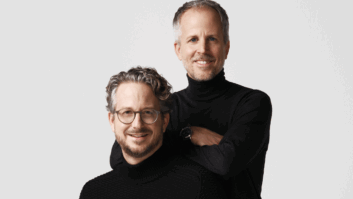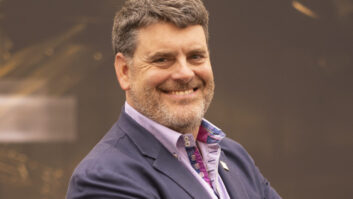
In his first UK interview since the capital alliance deal with Foxconn was signed, Sharp Visual Solutions Europe general manager Sid Stanley discusses what the agreement means for this proud manufacturer and the increasing significance of OLED technology in the marketplace.
Is there a sense of relief that the deal has finally been signed?
In simple terms yes. Over the past five years, at the corporate level, life has not been easy because of our well-publicised results and the difficulties we’ve had, like other Japanese electronics manufacturers. But actually Sharp as an organisation has learnt to just get on with the job and focus on what’s in front of us, so actually we have quite a resilient bunch of people.
Sharp people are going to come out of this with a new partner and all the benefits that will bring. But the added resilience in the organisation in Europe, having gone through the difficulties we have over the past five years, is another asset we’ve gained as well as a strong partner in Foxconn.
Has the uncertainty over the deal affected the company operationally?
We’re used to the background stuff as other people that work for Japanese vendors are. The thing that has affected us operationally for a long time is the lack of capital and the lack of fuel to invest in the best R&D and bring new products to the market. So it didn’t affect the day-to-day, or our customer’s confidence in Sharp, and it didn’t impact our results. The new partnership with Foxconn will now allow us to go on the offensive in terms of investment.
Were there other options for Sharp aside from this capital alliance?
Sharp was in a position of negotiating strength, with a number of parties in recent times declaring some sort of interest to get involved with us in one way or another. As our board publicised, we shortlisted both Foxconn and INCJ, which is the Japan-backed investment body.
There’s a lot of good stuff in Sharp, a lot of intellectual property, and there’s a lot of assets in terms of global sales and marketing coverage, a lot of inventions and R&D capability, and a lot of patents.
Despite the difficult results, there are a lot of assets in the business, which meant when Sharp went into discussions with companies, it was from an area of greater strength than people would appreciate, which allowed us to negotiate an alliance with Foxconn that is mutually beneficial. It’s been reported as a takeover and an acquisition, but actually the owner of Foxconn and the CEO of Sharp have been clear in their press statements that it’s a strategic alliance, while obviously Foxconn is the majority shareholder and is putting a lot of money on the table for the Sharp board to invest.
So that allows you to maintain your independence?
Yes. I would call it more of a marriage. Foxconn is not a global sales and marketing entity, they don’t have coverage of the markets, nor do they have a recognisable brand. But what they do have, and what Sharp needs, are brilliant production capabilities and economies of scale in the areas that we also broadly operate in. So that’s a 1+1=3 scenario.
What’s the feeling in the company about being the first major Japanese firm involved in a capital alliance with a foreign company?
I see excitement. One key point over the past five years since the downturn has been our financial stability, and we’ve had a number of discussions with the bank. We can now draw a line under that and move beyond that point without any doubts.
But I would say that the Sharp board has made a courageous decision. Despite what would have been a lot of pressure to pick the Japanese option in terms of INCJ, but they’ve been courageous in picking the best deal for Sharp and taken the deal on its merit and done the best deal for our shareholders, and most importantly for our people – our partners and our customers. There’s genuine excitement about what’s going to come out of Sharp and Foxconn in the future.
How do you think the investment in OLED displays will affect Sharp’s leadership in LCD? Do you have the resources to focus on both?
I think with the new investment the simple answer is yes. The money that Foxconn put on the table, the plan that the Sharp board came up with includes a large investment in OLED, but actually there are investments across a range of our technologies from MFP to digital signage, which means LCD, to energy solutions and so on. The investment from Foxconn allows us to invest on a number of fronts and quickly.
Is the future of the display market leaning more towards OLED or will it be a combination of both?
I think it’s difficult to look forward, but if I look back over my 20 years in the marketplace. If you look back at how plasma evolved and the economies of the scale it gets bigger and then it’s overtaken by LCD, and then we’ve got new platforms coming in terms of OLED, all of those transitions took a long time. And in some ways, if I think about the B2B marketplace, it does need innovation but doesn’t want it to happen too quickly around it because it operates at a slower pace than B2C.
In the Visual Solutions area, we’re still running a very successful interactive business with LCD at the heart. We’re still doing great business despite the fact that our R&D capability has been limited over the past five years.
But you can clearly see from the Foxconn side for their consumer-type areas and their relationship with mobile phone brands*, OLED is important for that aspect. Equally, Sharp will invest in its LCD manufacturing for digital signage as quickly as we’ll invest in OLED.
*Sharp and Foxconn are currently involved in Apple component manufacturing and assembly, and from 2017 Apple is expected to adopt OLED technology for iPhone displays.
There’s been talk of Sharp getting involved with the Internet of Things, is there any timeframe on when that will happen?
In the world of devices and displays, you recognise the trends we’ve seen in recent times. Smart meeting rooms, interactivity, collaboration, wireless connectivity and those sorts of things. We just now need to make sure that with the fuel that the investment from Foxconn will give us that we ensure our devices are appropriate to the ecosystems that are going to come into the commercial environment. And the IoT is going to drive another wave of adoption, another wave of usage, another wave of interconnectivity between devices and hardware and software. We need to make sure we’re providing products that are in sync with that market trend, but there are no specifics at the moment unfortunately.
In the longer term, what would constitute success for this partnership?
In terms of visual solutions, the market is dominated by Samsung in Europe, with a strong number two and number three in LG and NEC. I think there is space for another strong, well-invested manufacturer to bring an alternative to the market, with well-considered products, with a great channel and go-to-market strategy, managed by people that understand the needs of its customers, and I think that’s at least where Sharp needs to be, as quick as possible.
I think the market needs balance, needs good competition. The Japanese manufacturers and Sharp we’ve been great innovators in this space and that innovation has not gone away, all we’ve had is a lack of capital to bring that innovation alive in terms of products. But if I look at our 80in capacitive, that’s a fantastic product, it’s market-leading in its capabilities. So I would expect Sharp to be up there in five year’s time competing very well in all the marketplaces and producing very, very strong results.







